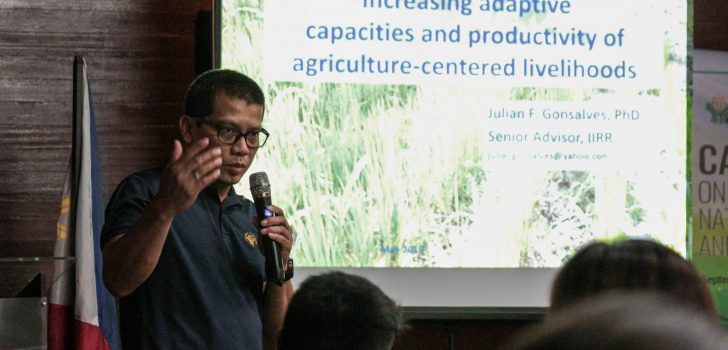 System-Wide Climate Change Office (SWCCO) Director U-Nichols Manolo giving his presentation at the capacity building seminar. (Photo by Joseph John Palarca)
System-Wide Climate Change Office (SWCCO) Director U-Nichols Manolo giving his presentation at the capacity building seminar. (Photo by Joseph John Palarca) PRDP Tackles Climate Change Resiliency & Biodiversity Conservation
One of the recommendations of the recently concluded 8th World Bank Implementation Review Mission is to incorporate climate change resiliency and biodiversity conservation in the commodity investment plans (CIP) of provinces and independent cities supported by the Philippine Rural Development Project (PRDP).
To that end, the PRDP Mindanao Cluster conducted a capacity-building seminar on climate change resiliency and biodiversity conservation last September 3-6, 2019 in Davao City. In attendance were representatives from the I-PLAN component, AMAD and HVCP of the different RPCOs.
The Philippines ranks at the top of the countries with the highest vulnerability to the impact of climate change. Consequently, the agri-fisheries sector stands to suffer the most from the hazards of changing weather patterns from typhoons to seasons of drought and extreme weather conditions such as El Niño. Studies made by the Food and Agriculture Organization (FAO) show that from the period of 2006-2013, the Philippine agri-fisheries sector accumulated losses and damages amounting to $3.8B due to typhoons, tropical, storms, floods and other natural disasters. It is estimated that without proper intervention measures, the Philippines would be forced to depend increasingly on food imports on such staples as rice, vegetables, pork to name a few to supply its growing population.
In his presentation, Systems-Wide Climate Change Office (SWCCO) Director U-Nichols Manolo outlined the need to adopt a climate risk vulnerability assessment (CRVA) framework to address risk reduction and agriculture resiliency in a changing climate. Developed for the Department of Agriculture (DA), the CRVA framework would assess the vulnerability of the agricultural sector on three areas, namely: sensitivity, exposure and adaptive capacity. The aims of the CRA approach are to 1) Increase agriculture productivity and income in a sustainable and environmentally sound manner (Productivity); 2) Build capacity of households and food systems to adapt to climate change (Adaptation); and, 3) Reduce greenhouse gas emissions and increase carbon sequestration (Mitigation).
Concurrently, there is also a need to put into consideration the conservation of biodiversity in the Philippines. Citing the number of species of flora and fauna endemic to the Philippines, DENR Regional Office 11 Chief of Conservation and Development Division Myrna Erlinda Arbiol emphasized that biodiversity and agriculture are interdependent. Maintenance of biodiversity is essential for the sustainable production of food and other agricultural products and the benefits these provide to humanity, including food security, nutrition and livelihoods.
I-PLAN head Cerenio Tila outlined the need to revisit the provincial commodity investment plans (PCIP) so they would incorporate biodiversity conservation, natural resource management & climate change resiliency. He acknowledged the need for harmonization and interagency convergence activities to address gaps and constraints relating to the environment with the goal of making value chains with long term sustainability. Further discussions are needed to update current value chains and reassess interventions and investments by PRDP. (Joseph John Palarca / PSO)

